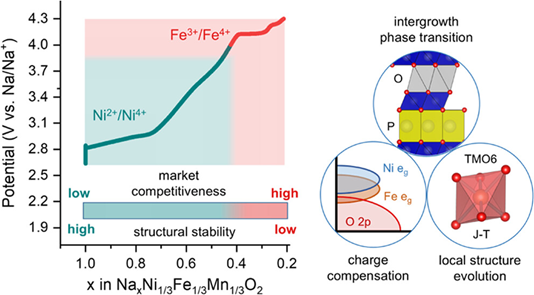Title: Elucidating the Structural Evolution of O3-type NaNi1/3Fe1/3Mn1/3O2: A Prototype Cathode for Na-Ion Battery
Authors: Kai Fang, Jianhua Yin, Guifan Zeng, Zixin Wu, Yonglin Tang*, Dongyan Yu, Haiyan Luo, Qirui Liu, Qinghua Zhang, Tian Qiu, Huan Huang*, Ziyang Ning*, Chuying Ouyang, Lin Gu*, Yu Qiao*, Shi-Gang Sun
Abstract: Extending the depth-of-charge (DoC) of the layered oxide cathode presents an essential route to improve the competitiveness of the Na-ion battery versus the commercialized LiFePO4-based Li-ion battery (0.8 CNY/Wh). However, the DoC-dependent boundary between detrimental/irreversible structural distortion and neutral/reversible structure interconversion cannot be clearly distinguished, which is attributed to the ambiguous recognition of correlation among the complex phase transition, local covalent environment evolution, and charge compensation. Herein, to bridge the above gap, we employed O3-NaNi1/3Fe1/3Mn1/3O2 as the prototype cathode and extended the target DoC from typical Na0.4 (∼125 mAh/g, 4.0 V cutoff) to Na0.2 (∼180 mAh/g, 4.3 V cutoff). Regarding phase transition and charge compensation, the O3-to-P3 phase transition occurs before moderate Na0.4-DoC (Fe/Mn redox silence, Ni oxidation dominated), while further desodiation (start from Na0.4) induces a P-to-O slab transition, resulting in the coexistence of P3 and OP2 phases and subsequent OP2/O3 intergrowth phases at higher DoC (Na0.2), upon which the Fe3+-to-Fe4+ oxidation is activated for capacity contribution. The local covalent environment presents severer deviation at high DoC (merely 0.2 mol desodiation from Na0.4 to Na0.2), which can be attributed not only to the slab gliding induced by the P-to-O slab transition but also to the further aggravation caused by the Jahn–Teller distortion of the FeO6 octahedron. Such irreversible distortion of the local covalent environment would be accumulated and evolved/deteriorated into structural degradation during long-term cycling. Furthermore, the rate-dependent artificial regulation of redox process has been demonstrated and the doping strategy toward structural stabilization has been proposed.

Full-Link: https://pubs.acs.org/doi/10.1021/jacs.4c11049